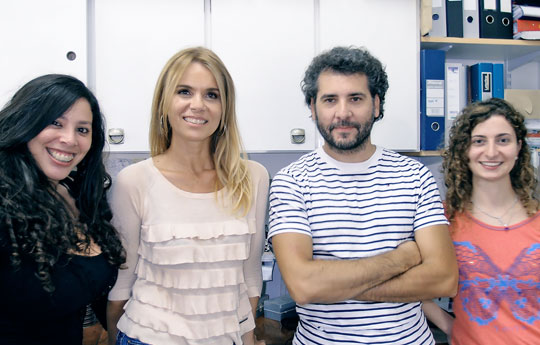IBR
A thousand and one strategies to resist and survive
CONICET researchers identified a gene that contributes to survival and bacterial virulence and could be a potential therapeutic target.
In every day life, people are in constant contact with a great number of bacteria. One of them is Pseudomonas aeruginosa, which is widely distributed in nature. It can be isolated from soil samples, pure and contaminated waters as well as from plants, animals and even healthy people.
This bacterium is very important at a biotechnological level but at the same time it implies a serious health problem. For this reason, a group of CONICET researchers from the province of Córdoba, lead by Andrea Smania, independent researcher of CONICET at the Centro de Investigaciones en Química Biológica de Córdoba (CIQUIBIC, CONICET-UNC), studies the adaptive mechanisms of this organism, particularly those ones connected with the control of mutation rate.
Now, in collaboration with a group of researchers conducted by Néstor Carrillo of the Instituto de Biología Molecular y Celular de Rosario (IBR, CONICET-UNR), the research team takes a step towards the understanding of the survival strategy of this bacterium, what could lead to new therapies to fight diseases caused by this infectious agent.
In a recent study published in PLOS Genetics, the scientists identified a gene in the genome of the Pseudomonas aeruginosa whose product enhances the survival and virulence of this micro-organism.
One in ten hospitals deals with cases of opportunistic infections with this bacterium, which affects immunocompromised patients, especially those who are in intensive care with cancer, HIV or burnt. However, there is a population group vulnerable to infections with Pseudomonas aeruginosa, composed of cystic fibrosis patients whose main cause of morbidity and death is associated with this disease.
In the fibrocystic lung and other pathological processes, the bacterium faces the oxidative stress of the host, and there is a correlation between virulence and the possibility of tolerating these oxidative assaults. Furthermore, Pseudomonas is resistant to a great number of antibiotics of different families whose mechanisms of action are, in many cases, associated with the generation of oxidative stress.
Research focus
“The great flexibility of the gene expression in Pseudomonas aeruginosa promotes its survival in varied environments and provides it with a unique versatility within the microbial world. Understanding how these mechanisms of adaptation work could allow us to block or reduce them and thus develop potential treatments to control the infections caused by this pathogen” Smania explains.
For his part, Carrillo comments that the isolated gene encodes a protein called flavodoxin, which connects different metabolic pathways, and has been systematically associated with antioxidant tolerance in many other microorganisms, but until now it has not been identified in Pseudomonas.
Besides, the researchers explain “it was found that flavodoxin expression in Pseudomonas aeruginosa increases under oxidative conditions, what suggests that it bears an antioxidant role. In fact, through genetic engineering methods, we obtain bacteria that do not produce flavodoxin – what is known as null mutants -. Thus, we noticed that they accumulate greater intracellular levels of oxidants and are less tolerant to the toxicity of hydrogen peroxide when compared to wild strains”.
At the same time, the presence of flavodoxine in Pseudomona aeruginosa decreases death and mutability caused by oxidative damage, and contributes not only to the survival of that bacteria in cells of the immune system but also to the infection model of the fly Drosophila melanogaster, which in turn increases the infection rate and the insect’s mortality.
”One part of the Pseudomonas aeruginosa is highly preserved, while a smaller part – but still significant – is variable and different in each strain of this bacterium. The flavodoxin’s gene is located in this variable region of the genome, algonside with other genes related to stress tolerance”, Smania reveals.
To conclude, the researcher highlights that the high conservation between strains, combined with the presence of these strain-specific genes, could explain the capacity of this bacterium to colonize diverse niches, including the human body.
In a particular ecologic niche, all bacterial population can exploit the genetic information of the species and, at the same time, each strain has its own sequences that are source of genetic variability, important for its evolution.
Thus, the results indicate that the flavodoxin provides adaptative advantages for the bacterium, contributing to its survival under oxidative conditions and hence its virulence. Due to the fact that the flavodoxins are not present in animals, this gene is a potential and interesting therapeutic target for the control of this relevant opportunistic pathogen.
- • Alejandro Moyano. Assistant researcher. CONICET. CIQUIBIC
- • Romina Tobares. CONICET fellow. CIQUIBIC
- • Yanina Rizzi. CONICET fellow. CIQUIBIC
- • Adriana Krapp. CONICET researcher. IBR
- • Juan A. Mondotte. Institut Pasteur.
- • José Luis Bocco. Principal researcher CONICET. CIBICI.
- • Saleh. Institut Pasteur.
- • Néstor Carrillo. CONICET Senior researcher.
- • Andrea Smania. Independent researcher. CIQUIBIC
- By Jimena Zoni. IBR
